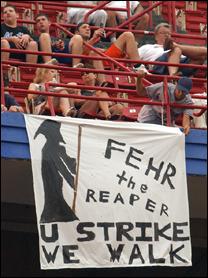
For example, if parties disagree about how large profits from a certain revenue stream would be, they could stipulate two different profit-sharing formulas based on their different predictions, and then see how the future plays out. When you add a contingency clause to your deal, you place a bet on how events will unfold. Contingent contracts are an innovative tool for resolving negotiators’ differences of opinion about the future. By building virtual-strike clauses into their contracts during collective bargaining negotiations, unions and management could create a situation in which strikes would not destroy long-term value to either side.

Presumably, the money rapidly accumulating in escrow during this “virtual strike” would motivate both sides to reach a deal. Rather, deposit these funds into an escrow fund to be disbursed only after the dispute was resolved. Sebenius proposed a novel solution, which unfortunately wasn’t followed: resume the MLB season, but do not allow owners and players to receive their revenues and pay. In the midst of the 1994 baseball strike, Harvard Business School professors Michael Wheeler and James K. Ask for an objective critique of your plans and encourage your expert to offer alternatives. Before going on strike, seek advice from a disinterested adviser, such as an industry expert.

When collective bargaining negotiations get heated, third parties can add a degree of rationality and impartiality to the proceedings. By looking for nuances in each other’s positions, we can open up opportunities to brainstorm the types of creative solutions we propose below. This is especially true in competitive situations such as competitive bargaining negotiations, where we tend to fall back on stereotypes. Far too often in negotiation, we assume we fully understand the other side’s interests and goals. To make matters worse, demands increase the tendency to escalate commitment to a strike. When you do so, you prevent yourself from considering alternative proposals that might meet your needs just as well. But making firm demands is usually a mistake.

When talks get heated, it’s tempting to draw a line in the sand. To avoid or end a strike in collective bargaining negotiations, follow these five steps and enhance your negotiation skills: Strikes often end up being a waste of everyone’s time and money.
#1994 MLB STRIKE NEWSPAPER HOW TO#
How to Defuse a Strike Using Collective Bargaining Negotiations The decision to cut our losses can be extremely difficult to make. Yet such “sunk costs” weigh heavily on us. Economists have long advised us to ignore our past investments of time, money, and other resources when making decisions about the future. When the decision to “hold out for a few more days” is repeated, a strike can last for months, even years.

When one side doubts the other side’s claims, a strike becomes even more tempting.
#1994 MLB STRIKE NEWSPAPER DOWNLOAD#
Download our FREE special report, Negotiation Skills: Negotiation Strategies and Negotiation Techniques to Help You Become a Better Negotiator, from the Program on Negotiation at Harvard Law School. Build powerful negotiation skills and become a better dealmaker and leader.


 0 kommentar(er)
0 kommentar(er)
